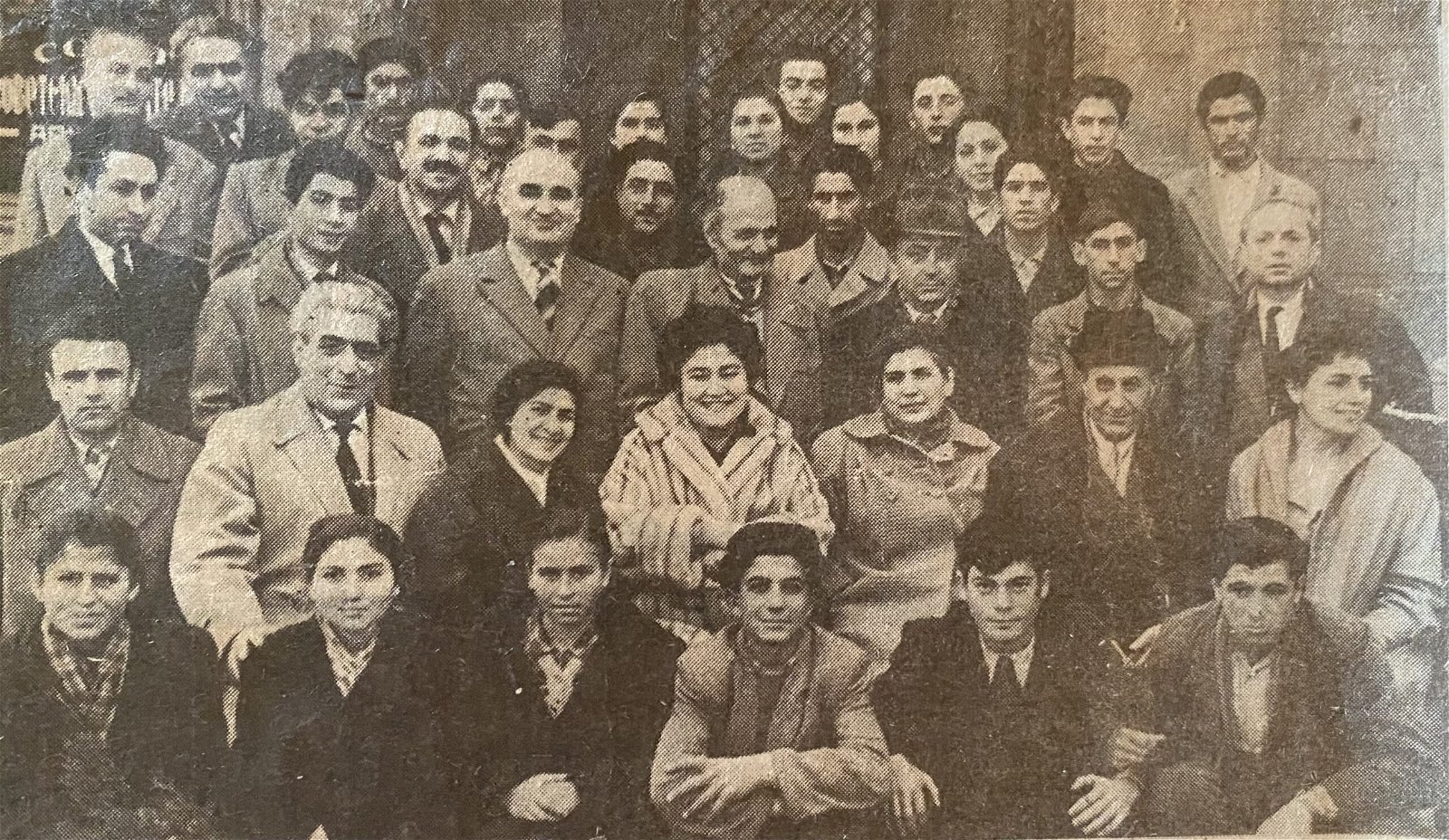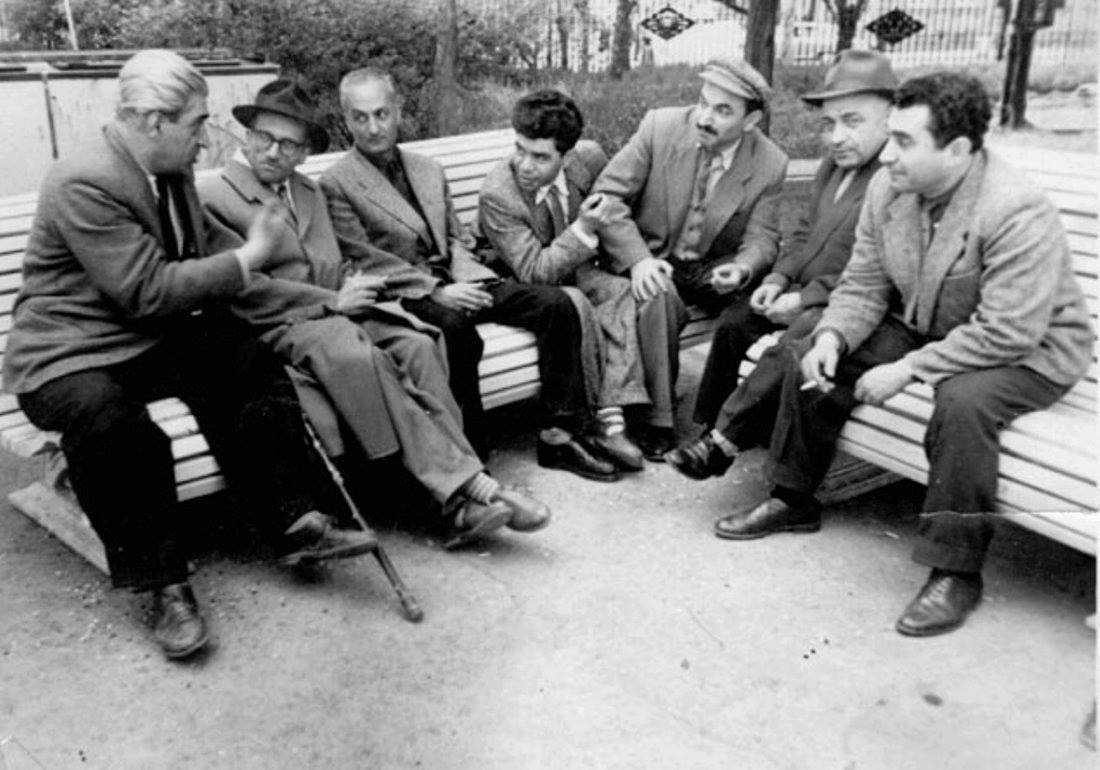
“After hearing the news, he stood at the front of Sevak’s apartment door for several minutes and wept. Everyone could hear the sound of his anguish.”
According to my mother, that was her grandfather’s reaction to Paruyr Sevak’s sudden death. She watched with somber eyes at the young age of ten, knowing in her heart that something terrible had happened. But how could that be? Only yesterday she was playing in the courtyard with Sevak’s youngest son Koryun. Only yesterday did she knock on Sevak’s door. Only yesterday did she see the merry face of his wife Nellie.
The Writer’s Building on Kasyan Street, which housed different prominent writers, was in utter confusion and agony, tears and flowers raining down from every floor.
My mother’s grandfather, playwright Aramashot Papayan, loved Sevak deeply. Their friendship may have been unusual for some due to their age difference, but their shared worldview and artistic taste sealed the gap of years between them and fostered a wonderful relationship. But what made their relationship even more meaningful was their shared memory and love for Aram Papayan.
Aram Papayan was Aramashot Papayan’s nephew, but everyone knew him as his brother because they were so close in age. Aram Papayan was a journalist, editor, writer and a deputy commissioner at the commissariat of Yerevan during WWII. He also co-wrote plays with Aramashot Papayan, who at the time was only called Ashot Papayan, his birth name. They met great success with the play The Great Wedding in 1944, and their artistic future seemed to be filled with promise, until the unthinkable happened.

Four months after WWII ended, Aram Papayan went to greet the returning soldiers of the Armenian Tamanyan Division. On his way there, out of nowhere, a car crashed into the vehicle he was in. For three days, Aram Papayan lay in a coma at a hospital, succumbing to his injuries on August 28, 1945. Armenia lost a promising playwright and a leading editor.
Ashot Papayan’s life changed forever, and in memory of his nephew, he changed his name to Aramashot Papayan. This way, their names would forever be intertwined, and Aram Papayan would always have writing credits on every play Ashot Papayan would write in the future.
Sevak met Aram Papayan in 1941, a few years before his death. It was purely a meeting of fate. The following story was first recounted to me by my great-aunt and was told with immense love and heartfelt warmth. But this story is one of great accuracy and has first-hand documentation to confirm its validity. I have pulled directly from the words and documents of Hovhannes Ghazaryan, a literary scholar, critic, Writers Union member and candidate of philological sciences. He was responsible for preserving many of Sevak’s works and documents and even provided his collected sources to Albert Aristakesyan, also a literary critic, doctor of philological science and Writers Union member, who wrote extensively on the life of Paruyr Sevak, including a published biography.
According to Ghazaryan’s written records, in 1941 he was approached by Susan Barayan, the fiancée of one of his friends who was serving in the war and a student at Yerevan State University. At the time he was teaching at a literature institute. She handed him two large, black notebooks, which held the poetry of a fellow student. His name was Paruyr Sevak, and he was a graduate student of philological sciences at Yerevan State University. Barayan asked Ghazaryan to read over Sevak’s work and to give his opinion on them.
Ghazaryan was very moved by Sevak’s poetry and was struck by a controversial thought, something he described as “criminal,” “absurd” and “hideous.” The thought in question was “how to free Paruyr Sevak from military duty, from an all-consuming war.”
During WWII, men were being drafted to fight on behalf of the USSR, with Joseph Stalin at the reins. Being drafted meant inevitable death, not only because of the war itself, but because of Stalin’s grotesque human rights violations against his own people, where his soldiers and military officers were often executed or sent to the Gulags.
Ghazaryan was desperate to save Sevak, to preserve this exceptional talent for the sake of Armenian culture. “Paruyr was going to be the poetry of tomorrow and the epic dawn of Armenian literature,” he recalled thinking. But doubts swirled in him. “Maybe I am deceived. Maybe the magic of Paruyr, a poetic miracle, was just a mirage.”
During an accidental run-in with a friend in Lenin Square, a Khachatur Abovian Pedagogical Institute economist lecturer, Ghazaryan shared with him his discovery of Sevak’s works and the possibility of saving him from the draft. The lecturer promised to think it over, eventually deciding against it as it would cause controversy and danger for any government official involved in this act, especially with Stalin in power.

When Ghazaryan met Sevak in person, he unequivocally decided that action must be taken to protect him. He prepared to seek the advice of a dear friend, Aram Papayan. Ghazaryan described him as “knowledgeable,” “tactful” and someone he “trusted unconditionally.”
“Paruyr, my beloved,” he said to Sevak. “Take hold of your poetic weapons. Tomorrow we will go somewhere.” Sevak agreed to go and said, “My poetic weapons are always ready, if they are necessary.”
Sevak’s military papers were being held in the commissariat of which Aram Papayan was the deputy. Ghazaryan felt sure that Papayan would understand Sevak’s poetry, as he loved poetry himself and had a “poetic spirit.” Ghazaryan stood steadfast in the hope that Papayan would help free Sevak from the draft fearlessly and with the “heart of a mother.”
The car ride the next day was silent on the way to Papayan. When they arrived, they entered his office. “Aram, my beloved,” Ghazaryan said. “Please, I ask you to carefully listen to this young man, Paruyr.”
Papayan closed the door and asked Sevak to please share his work with him. In the silence of the office, Sevak firmly and slowly read his poetry. Ghazaryan asked Papayan his thoughts when Sevak finished. “Excellent,” said Papayan.
Sevak was deeply moved by Papayan’s reaction and excused himself to go smoke, expressing his deep gratitude to Papayan before exiting the office.
“Aram, is it possible to save this man from going to the army?” asked Ghazaryan when Sevak had left.
Papayan huddled in his armchair and thought deeply for a while. Then, without saying a word, he jumped out of his seat and opened the door of his office and rushed out. He returned with Sevak’s military card and opened his fireproof closet, placing the card inside.
“This card will remain here, as an untouchable relic, for as long as I live,” whispered Papayan. “The key of this closet is with me only.”
“Sevak, the creator, was saved from destruction,” recalled Ghazaryan.
A few years later Aram Papayan was killed in an automobile accident that many believed, similar to Sevak’s accident, was deliberately planned. It seemed to be a premonition of what was yet to come.
It wasn’t until 25 years after Aram Papayan’s death that Sevak could muster up the heart to publicly talk about him, whom Ghazaryan deemed his “savior.” In 1970, Sevak penned an open letter to Papayan on the anniversary of his death where he said that “brothers aren’t only by blood.” Sevak titled the open letter “The Dead Don’t Age,” in which he wrote that Papayan was a “victim of a blind car and incoherent accident.” The letter was originally published in Literature Newspaper. The full English translation of the letter can be found here: https://www.aramashotpapayan.com/aram-papayan
“Beautiful, tall, broad, with honest features. My generation first saw him in military uniform,” wrote Sevak about Aram Papayan. “It seemed to me that he was just born like that, in uniform. But those close to him knew he was more beautiful on the inside, and that he was infinitely far from wearing a uniform and doing military work. He was born an artist, and he himself was a beautiful work of art.”
Approximately a year after writing this open letter to Papayan, Sevak himself would fall victim to an “incoherent accident” on June 17, 1971 near Chanakhchi village. Sevak lost control of his car and plunged into a valley. According to accounts of the accident, a reckless truck driver was involved and Sevak’s novice skill in driving played a part in the accident. Sevak lost his life instantly, while his wife died in the hospital an hour later and his two sons survived with minor scratches.
Going back to Kasyan Street in the Writers Building, Aramashot Papayan, who had lost his nephew Aram Papayan to a tragic accident years ago, lost his dear friend Sevak to the same tragedy. His dear Sevak, who always greeted his daughter endearingly and sat with his son in deep poetic conversation, was gone forever.
While writing about Aram Papayan, Sevak had encapsulated their fates with precision, “Beautiful victim, ugly victimhood.”




Thank you!
Thank you for this enchanting article. I am a huge fan of Paruyr Sevak. I not only enjoyed the new found knowledge about Sevak’s life, his work and his friendships, but also learning about your grandfather Aramashot and uncle, Aram.